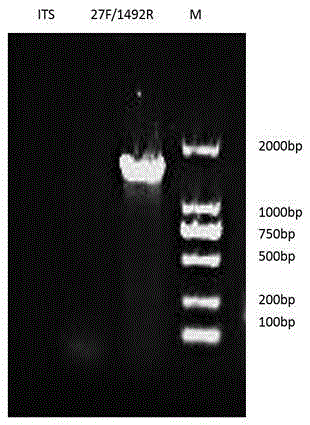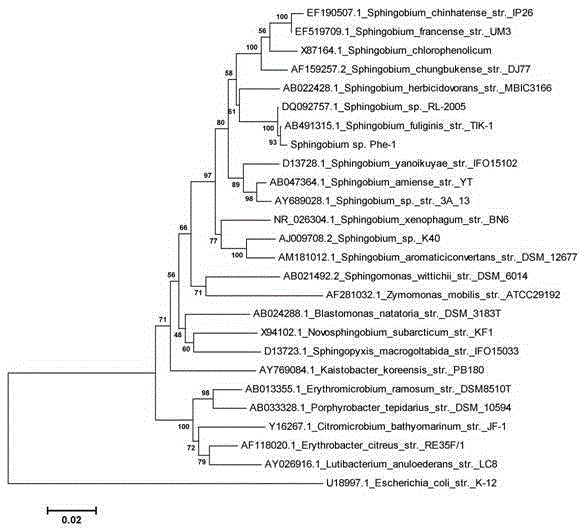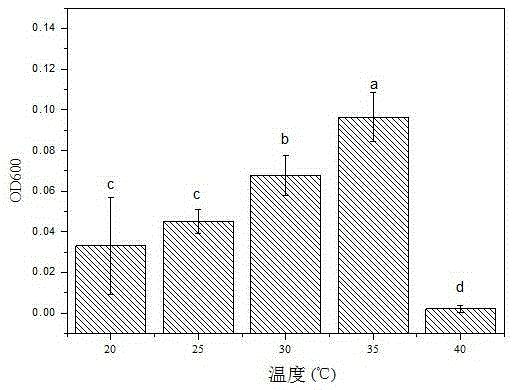Effective degradation strain for phenanthrene Sphingobium sp. Phe-1 and application thereof
A high-efficiency, strain-based technology, applied in bacteria, water/sludge/sewage treatment, biochemical equipment and methods, etc., can solve the problems of insufficient degradation degree and degradation time, and achieve good degradation advantages, wide application range and loose conditions. Effect
- Summary
- Abstract
- Description
- Claims
- Application Information
AI Technical Summary
Problems solved by technology
Method used
Image
Examples
Embodiment 1
[0048] Example 1 Screening of Phenanthrene Efficient Degradation Strains
[0049] 1. Soil samples
[0050] The soil samples were collected from the oil refinery in Longtang Town, Qingcheng District, Qingyuan City (N23°36′20.86″N, E113°04′19.34), removed the debris, put them in sealed bags, and stored them in a refrigerator at 4°C.
[0051] Soil suspension preparation: Weigh 10g of soil into 90mL of high-purity water, shake at 30°C and 180rpm for 30min.
[0052] 2. Screening of high-efficiency degradation strains
[0053] (1) Enrichment culture
[0054] Take 0.5 mL of phenanthrene standard solution in a dry and sterilized Erlenmeyer flask, wait for the acetone to volatilize completely, measure 90 mL of inorganic salt liquid and culture it in the Erlenmeyer flask, then measure 10 mL of soil suspension in the Erlenmeyer flask, so that the concentration of phenanthrene is 10 mg / L, incubate at 25°C, 160rpm in the dark for 5 days. Increase the concentration of phenanthrene to...
Embodiment 2
[0082] Example 2 Phenanthrene efficient degradation bacterial strain Sphingobium sp. Study on the Growth Characteristics of Phe-1
[0083] 1. The effect of temperature on the growth of degrading bacteria
[0084] (1) Using phenanthrene as the sole carbon source, the effects of different temperatures on the growth of the degrading strain Phe-1 were explored.
[0085] A certain concentration (the number of cells is about 10 9 / mL) bacterial suspension was inoculated into 20mL inorganic salt medium (50mg / L phenanthrene content) at a ratio of 1%, and cultured on a shaker at 160rpm for 24h. The culture temperatures were 20°C, 25°C, 30°C, 35°C, and 40°C, respectively. Three parallels were performed for each sample, and the OD600 value was measured, and the average value was calculated. Select the optimum cell growth temperature.
[0086] (2) The results are attached Figure 5 shown. From the experimental results, the degrading strain Phe-1 is highly sensitive to temperature...
Embodiment 3
[0101] Embodiment 3 phenanthrene highly efficient degradation bacterial strain Sphingobium sp. Phe-1 Degradation Ability Determination
[0102] 1. Taking phenanthrene as the only carbon source, the concentration of phenanthrene is 100mg / L, inoculate the degrading strain Phe-1 bacterial suspension at 1%, and measure the degrading strain under the optimum conditions (pH 7.0, rotating speed 160rpm, temperature 35°C) Phe-1 degradation curve.
[0103] The specific method is: a certain concentration (the number of cells is about 10 9 / mL) bacterial suspension was inoculated into 20mL inorganic salt medium (phenanthrene content 100mg / L, pH 7.0) at a ratio of 1%, and cultured on a shaker at 160rpm and 35°C for 0, 1, 2, 3, 4, After 5 days, the whole bottle was extracted, and the residual amount of phenanthrene was determined. Three parallels were performed for each sample, the average value was calculated, and the degradation curve of the degrading bacteria was drawn. Control: ad...
PUM
 Login to View More
Login to View More Abstract
Description
Claims
Application Information
 Login to View More
Login to View More - R&D
- Intellectual Property
- Life Sciences
- Materials
- Tech Scout
- Unparalleled Data Quality
- Higher Quality Content
- 60% Fewer Hallucinations
Browse by: Latest US Patents, China's latest patents, Technical Efficacy Thesaurus, Application Domain, Technology Topic, Popular Technical Reports.
© 2025 PatSnap. All rights reserved.Legal|Privacy policy|Modern Slavery Act Transparency Statement|Sitemap|About US| Contact US: help@patsnap.com



